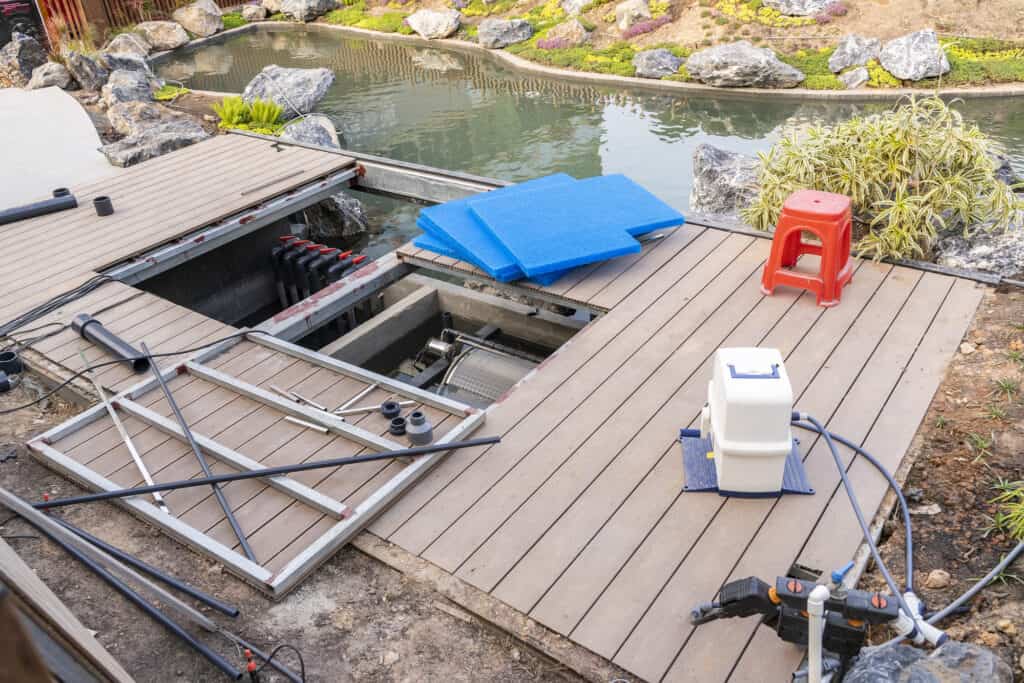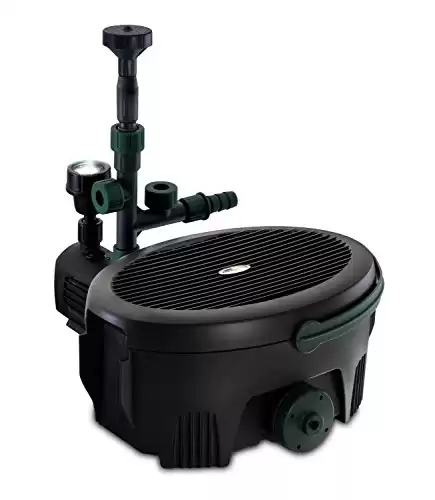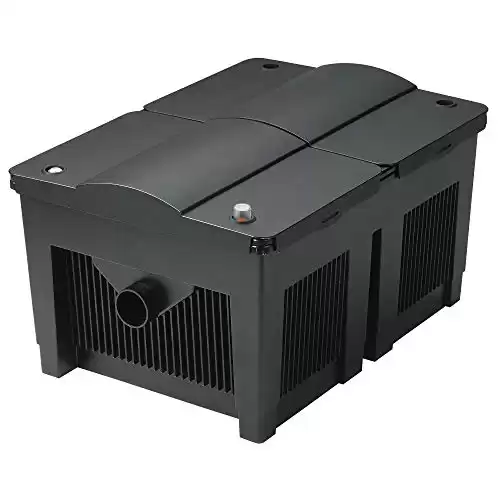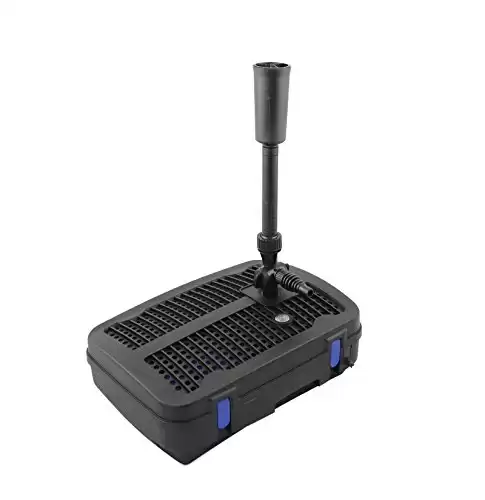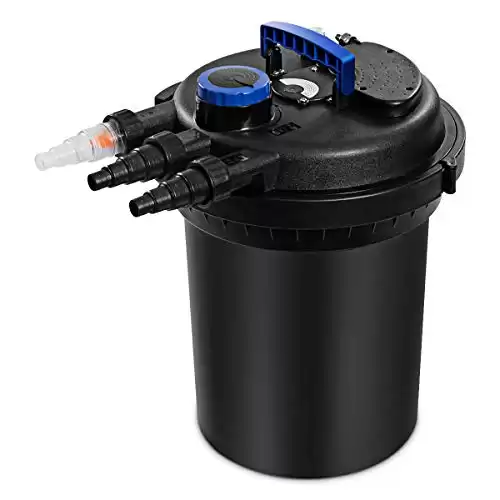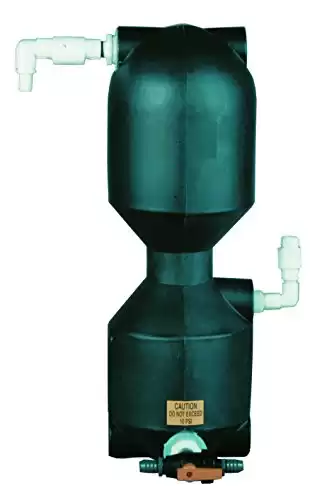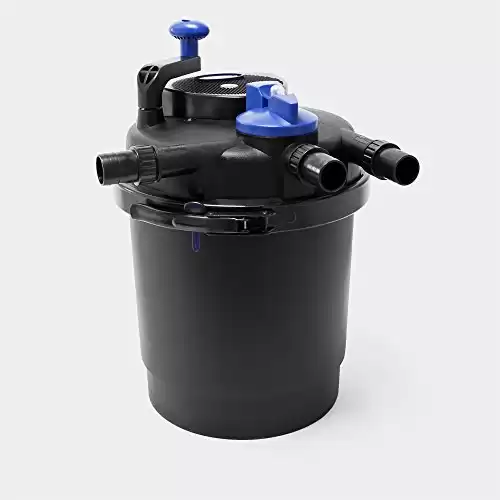Water filtration is a key factor in keeping your fish healthy. Filters can help to remove toxic substances and improve water quality. Koi fish are very sensitive to changes in water conditions and can quickly become ill from poor water quality.
|
Primary Rating:
4.4
|
Primary Rating:
4.5
|
Primary Rating:
4.3
|
But what koi pond filtering systems are best? We’ve done all the research for you to make the best choice.
What To Expect From A Filter
There are a few key things that a quality koi pond filter should have, including:
Proper Biological Filtration
For beneficial bacteria to do their job, they need a large surface area and the right amount of water flow to create oxygen to feed on toxic substances. Look for a filter that provides good water movement and optimized biological media.
Proper Mechanical Filtration
Although biological filters are very important, you’ll also need a filter with good mechanical media. Look for a filter with a few different mechanical media layers to catch multiple debris sizes.
Provides Maximum Water Quality
Look for a filter that can help keep good water quality all year round. A filter that is easy to clean and maintain and provides adequate water flow is key to optimal water quality.
Oase BioSmart Filter
- BioSmart 10000 is suitable for ponds up to 10,000 gallons (with no fish).
- High-surface area filter foams provide exceptional biological filtration capability.
This non-pressurized filter is great for large ponds. It offers biological and mechanical filtration for ponds from 5,000 to 10,000 gallons. It houses multiple biological filters with lots of surface area for beneficial bacteria to grow.
The filters are easy to clean with a built-in cleaning gauge. Turn off the pump and pull the sludge drain handle to clean.
Things We Like:
- Multiple zones of biological filtration
- Easy to clean
- Great for large koi ponds with multiple fish
- It comes in two different sizes
Things That Could Be Improved:
- The instillation instructions aren’t great
- It doesn’t have a UV filter
Goplus Bio Filter
- celled algae by reducing its ability to reproduce. It is suitable for improving the water quality to provide a clear and healthy pond for your fish.
- suitable for ponds with normal fish load 2500 gal and ponds with heavy fish load 1500 gal. With such powerful capacity.
This pressurized koi pond filter provides great filtration for various koi ponds. This filter also has a UV clarifier to eliminate toxic bacteria and parasites from the water.
Due to its canister housing, cleaning is simple. You can unscrew the canister and access all parts of the filter.
This pump is a great budget-friendly option for a koi pond filter. It’s great for ponds of up to 4,000 gallons.
Things We Like:
- It has a UV filter
- Easy cleaning
- Affordable
- Great for smaller pond
Things That Could Be Improved:
- It doesn’t provide proper oxygenation for crowded koi ponds
- Filter housing can leak
- No warranty
Bubble Bead Filter
- A go-to for professionals in the aquaculture and aquaponic space.
- Get robust and efficient water filtration for your aquarium.
- Advanced filtration for koi ponds up 1000 gallons.
This pressurized filter is great for a koi pond of any size. The Bubble Bead filter is ideal for easy cleaning.
A simple backwash is usually needed to clean the system without removing the filters.
This filter specializes in mechanical filtration and is available for many pond sizes from 300 to 20,000 gallons.
Things We Like:
- Easy cleaning without having to take everything apart
- Great mechanical filtration
- It comes in so many sizes for a variety of ponds
- Great customer service
Things That Could Be Improved:
Koi ponds are becoming more popular among aquarists. Koi ponds come in different depths, sizes, and more, but no matter what kind of koi pond you have, you’ll need a filter to keep your pond healthy.
We’ve done all the research for you if you don’t know where to start with a koi pond filter.
- No UV Filter
- No warranty
SUN Grech Pond Bio Filter
- Able to cope with higher water flows compared to traditional gravity filters
- Complete with inlet and outlet hose adapters.Outlet/Inlet hose adapter 3/4 inches~5/4 inches
This pressurized filter has a powerful flow rate with several filtration stages for a clean pond.
This filter has separate chambers for the biological and mechanical filters for efficient filtration. This filter also has a UV light for filtration to kill harmful bacteria and algae.
This filter is a great choice for beginners with its easy installation. It has everything you need for a quick setup to maintain up to 1600 gallons of ponds.
Things We Like:
- It can be used for higher water flow rates
- Easy cleaning
- UV filter
- Affordable
Things That Could Be Improved:
- Can’t be submerged
CNZ Pond Filter
- Reduce algae, Clean Pond water
- 3 Fountain Water Feature Attachments
- Adjustment valve for regulating flow to fountain head and/or auxiliary water feature.
This koi pond filter is a great all-in-one filter for beginner pond keepers. It boasts a 660 GPH flow rate for medium-sized koi ponds. It’s also compact for easy movement. This filter is fully submersible for a natural look.
Things We Like:
- Adjustable water flow options
- UV Filter
- Multiple filter media
- Submersible
Things That Could Be Improved:
- Expensive maintenance
Aquagarden Water Filter
- Two-year guarantee for added peace of mind
- LED spotlight 1 watt - enjoy your pond day and night
- Fountain feature - 3 beautiful fountain heads
- Safety switch – built in automatic magnetic safety off switch for the UV
This submersible water filter is a great option for small koi ponds. This filter is super lightweight for small ponds up to 600 gallons.
Even though it’s for small koi ponds, it has LED and UV lighting. It has a 3-stage filtration system to catch debris polluting your pond water.
Things We Like:
- Super lightweight
- LED light
- UV Light
- Multiple output options
Things That Could Be Improved:
- It can only be used for small ponds up to 600 gallons
How Much Filtration Is Needed for Your Pond?
The amount of filtration you need for your pond depends on two factors. Filtration depends on the size of your pond and the number of fish you keep.
Filters are usually rated for the amount of water volume they can filter, but a pond with more fish requires more filtration because of the amount of waste the fish will produce.
Getting a filter that can filter twice as much as the number of gallons in your pond is best. For example, if you have a pond that is 1,000 gallons, get a filter that can filter at least 2,000 gallons. If you have lots of koi fish in your pond, use a 4,000-gallon filter for the 1,000-gallon pond.
Pressurized Versus Non-Pressurized Filters
Pressurized filters are typically installed below ground level and offer flexibility when designing a koi pond. Pressurized filters will have slower water flow than regular filters.
Slower movement gives the filter more time to process water and collect debris and toxic substances. The main drawback to a slower flow rate is that beneficial bacteria can die due to their need for oxygen.
Pressurized filters are less ideal for koi ponds with lots of koi fish. To make a pressurized filter work for this type of koi pond, they will need a pre-filter and potential additional bacteria.
Benefits of Pressurized Filters
- Good mechanical filtration
- Can filter large volumes of water
- Flexible instillation
- Easy cleaning
Drawbacks of Pressurized Filters
- Biological filtration isn’t always Ideal
- Top-end filters can be expensive
Non-Pressurized Filters
Non-pressurized filters are great for biological and mechanical filtration while keeping optimal water pressure. You are more limited with instillation, however.
Top non-pressurized filters have a level of debris removal like expensive bead filters.
They usually have multiple layers of mechanical media for the best debris collection.
Although they cannot filter debris as quickly as pressurized filters, they provide great biological filtration, especially for ponds with large amounts of koi fish.
Benefits of Non-Pressurized Filters
- Optimal Biological Filtration
- Great Mechanical Filtration
- Affordable
- Easy to Clean
- Great for ponds of all sizes
Drawbacks to Non-Pressurized Filters
- Installation options aren’t as flexible
Other Factors to Consider When Buying A Filter
There are a few other factors to consider when choosing a koi filter.
Flow Rate
The flow rate is a crucial factor to consider when buying filter systems. Using a filter with a low flow rate in larger ponds can cause increased toxicity, especially in koi ponds, as koi fish produce lots of waste.
To find the correct flow rate for your pond, multiply the pond’s volume by 1.5. This will give you the minimum flow rate to keep your pond healthy. For example, if you have a 1,000-gallon pond, buy a filter with a flow rate of 1,500 gallons per hour.
Looks
Many filters have aesthetic elements that can add to the beauty of your koi pond. Filters with fountain outlets or special lighting systems can further improve the look of your pond.
If you’re looking to have a gorgeous pond, you’ll want to find a filter that can benefit your pond’s aesthetic nature.
Features such as built-in LED lighting systems can improve the overall look of your koi pond.
Filter System
A koi pond can be one of the most challenging pond types to maintain. A sufficient filter is crucial to the health of your pond.
Filter systems with proper media, such as a filter with strong mechanical, biological, and chemical filtration, are needed to clean waste and other debris from your pond.
Shape and Size
Pond filters can be bulky, depending on the type. Some also have fountains or other water outlets that require them to be located close to your pond’s surface. Especially if you have a smaller pond, it can be hard to find the right filter.
It’s best to check the size and shape of the filter and decide where you’ll be putting the filter before you buy one.
Heat Production
A heavy-duty filter can produce lots of heat because it must run constantly. In the long run, this can cause issues for your koi pond.
Especially if you live in a warm client, maintaining temperature can be a problem. Looking for a filter with good heat management can prevent future problems.
Certain filters are made without internal moving parts to reduce the amount of heat they give off.
Should You Add a Pre-Filter to Increase Filtration?
Pre-filters can be a great option for koi ponds with more fish but can also work for ponds with fewer fish if you want great water quality.
Pre-filters are secondary filters that collect debris before the water gets to your main filter.
A pre-filter comes in many forms, from skimmers to leaf baskets or even a second filter.
If your pond has lots of fish and debris, pre-filters are a great option for keeping your pond clean.
If you decide to pre-filter with another filter box, ensure that your pump is strong enough for both filters.
Carbon and Beneficial Bacteria
In addition to a pre-filter, activated carbon and extra beneficial bacteria can be used to maintain water quality. Testing your water monthly after choosing a new filter can help to gauge if your filter is working for your pond. If you are seeing small increases in ammonia and nitrites, adding beneficial bacteria can keep this to a minimum.
Adding activated carbon every few months can also help to reduce substances that your biological filter can’t remove, like chlorine, pesticides, and fertilizers.
How To Set Up Your Koi Pond
You’ll need some key parts to set up your pond if you want healthy Koi fish. Before you choose a filter, it’s best to understand the basic tools you’ll need for your pond and what they do.
Bottom Drain
The majority of ponds will have a bottom drain. The bottom drain is usually the pond’s deepest part that helps clear debris.
Ponds that don’t have a bottom drain will build up waste quickly and need to be cleaned.
The water that flows down to the bottom drain moves to a settlement tank. Ensure that the water flow rate matches the size of the bottom drainpipe. Slow flow can cause heavy particles to settle in the bottom drain.
Skimmer
Skimmers are alternative mechanical filters. The skimmer grabs floating debris from the top of the pond. The skimmer can also remove dissolved organics.
If you don’t have a skimmer, the surface of your pond can build up an oil film and reduce the amount of oxygen the pond gets from the atmosphere. It’s best to get a skimmer with the widest width available to clean your pond surface quickly.
The skimmer also has a basket to collect large debris to prevent it from clouding the pond’s surface or going into your pump.
UV Sterilizer Filter
If your filter choice doesn’t come with a UV filter, you’ll need one. A UV filter passes a UV light over the pond water, which helps to disrupt a microorganism’s chemical bonds to kill them. This kills bacteria, viruses, algae, and more.
The UV sterilizer or clarifier is usually placed before the mechanical filter.
UV Sterilizers Versus UV Clarifiers
There isn’t much of a difference between the two. Clarifiers kill algae specifically, while a sterilizer kills all the additional pests, such as viruses and bacteria.
Depending on the size of your pond, the device may work more as a sterilizer or clarifier.
A single UV light source may act as a sterilizer for a small pond, but for a larger pond, it may only act as a clarifier. It all depends on the wattage and size of your pond.
UV bulbs are not cheap; however, viruses and bacteria create most water quality problems in a koi pond. This is why getting a filter with built-in UV is best to save you some money.
Ion Filtration
Ion filtration is a new concept. It’s a compact system that kills algae, viruses, and bacteria.
Ion filtration uses a chamber with two low-voltage diodes that give off positively charged ions to attract algae, fungi, viruses, and bacteria.
The electric current is minimal, so there isn’t a detrimental effect on your fish, and it’s also affordable to operate.
Ozone Filtration
Ozone filtration is the most powerful tool to destroy contaminants. It is 50 percent more powerful than chlorine.
Ozone also breaks down into oxygen, so it also oxygenates the water, which is an added benefit.
Ozone filtration passes air through the filter, which is applied to an electric current to create ozone gas.
The gas is pumped into a chamber, and water is within the chamber. The ozone destroys viruses, bacteria, and other contaminants, which then converts them back into oxygen.
Plant Filtration
Plant filtration is one of the simplest filtration methods. Aquatic plants both provide filtration as well as shade for your koi.
They also provide the pond with dissolved oxygen. Aquatic plants add functional and aesthetic value to your pond.
FAQs
Are Sand Filters Good for Koi Ponds?
Sand filters can work for Koi ponds. Sand filters work to trap large amounts of solid debris like algae. Sand filters have their benefits and drawbacks, just like any other filter.
Sand filters are great for koi ponds because they’re small and can be easily hidden. Filtered water can be sent back into the pond or biological filter. They’re also a bit cheaper.
One drawback to using a sand filter for a koi pond is that it can easily become clogged in a koi pond and will need backwashed several times a week.
Also, for a pond more than 2,000 gallons in size, you’ll need more than one sand filter.
Will a Pressure Filter Work for a Koi Pond?
Pressure filters can be used as stand-alone filters if you have a small or medium koi pond.
They can be used with a skimmer and another filtration system for larger ponds. They’re very easy to install, so they’re great for just about any pond.
Pressure filters are also self-contained, so they can be placed on or partially in the ground.
Can a Pond Filter Be Too Big?
For pond filtration, bigger is always better. You can’t really have too big of a filter for your pond.
A larger filter has a larger surface area and shouldn’t need to be cleaned as often. Although filters are expensive, so are replacing several fish that have died from poor water quality.
Filters do come in a range of prices. However, while less expensive filters work well, they’re usually harder to clean.
If you’re looking for a new filter for your pond, find the recommended size and then go one size up.
How Often Should You Backwash a Koi Pond?
Backwashing is a method of cleaning a pond’s filtration system. Backwashing works by reversing water flow to flush out toxic substances.
This method helps to clean the system without having to scrub all the components.
Depending on the type of filter, you’ll need to backwash at different intervals. If you are using a biological filter, it’s best to backwash it bi-weekly.
Make sure to check your pressure gauge often. If your gauge is reading high, you might need to backwash it more often.
If you have an excess amount of water coming from the pond outlet, this is a signal that the filter should be backwashed.
Can You Use a Pool Pump for a Koi Pond?
While swimming pool filters could be used for a koi pond, it’s not recommended. Swimming pool filters are designed for chemical and mechanical filtration.
They also rely on a pump that only operates at a set time every day. Pumps for biological filters need to run 24 hours a day.
Using a swimming pool pump for your koi pond can quickly get expensive.
Do Koi Ponds Require Lots of Maintenance?
Koi fish are definitely high-maintenance fish because they produce lots of waste compared to their size.
They can also disturb the surface of your pond and bring debris into the water more quickly than other fish. This is why a good filtration system is key.
Which Filter is Best?
The best filter for your pond comes down to several factors. It depends on pond size, the number of koi fish in your pond, your budget, and the look you’re trying to achieve for your pond.
Some filters have options for both small and large koi ponds or even a small koi pond with lots of fish. It all depends on your specific goals for your koi pond.
Final Thoughts
There are many different filters with different features to meet your specific needs.
Our top pick is the Oase BioSmart Filter. The variety of sizes offered makes it suitable for a koi pond of any size, and the multiple zones of biological filtration are designed to keep your pond cleaner for healthy koi fish.

